Potato curries and Poori are a popular combination, when it comes to breakfast or brunch meals in Indian cuisine. This pair has various regional variations too. One such variant is the Poori Masala or Puri Curry. My recipe is a delicious hotel style version to make the potato curry or gravy enjoyed with the Indian fried bread Poori. This is a South Indian style recipe made with boiled potatoes, lots of onions, spices, lentils and herbs. Make this flavorful and tasty dish for a comforting weekend breakfast at your home.
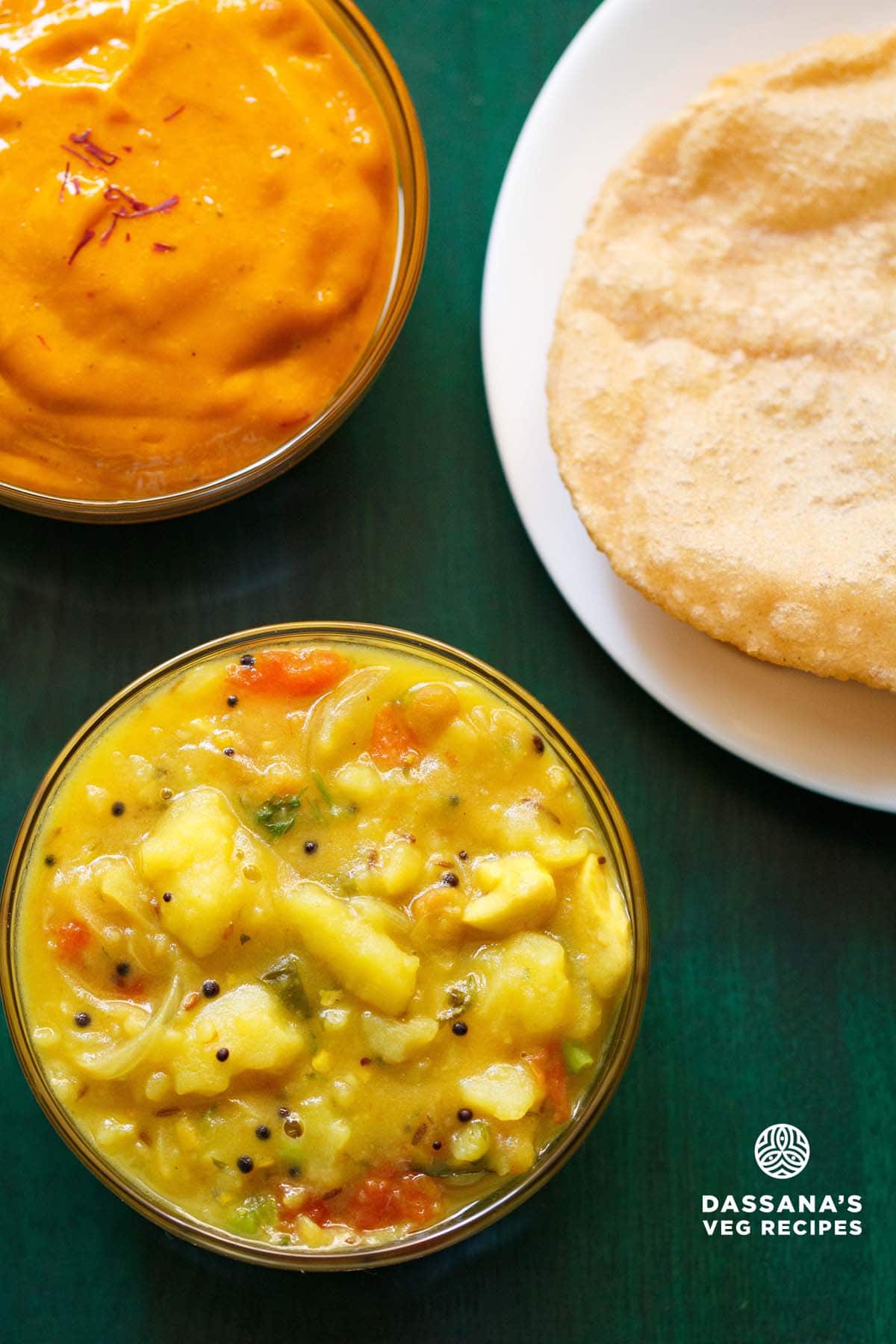
About Poori Masala
Poori Masala, as the name suggests, is a well-known dish from South India that consists of deep-fried bread called ‘poori’ served with a flavorful, creamy and tasty potato curry known as ‘masala.’
This dish has its roots in South Indian cuisine, particularly in states like Karnataka, Tamil Nadu, Andhra Pradesh and Kerala. It is a traditional breakfast or brunch combination; is considered a festive treat and is often part of celebratory feasts.
There are many potato-based curries made in the vast Indian cuisine. Like I said, this particular Puri Curry recipe is a special and unique potato gravy that is mostly served with pooris in the food culture of South India.
Table of Contents
Also do not confuse it with the Potato Masala that is made for dosa. The dosa potato masala is dry, may include tomatoes or not, while poori masala has a curry like consistency and usually has tomatoes added to it.
However, the taste of the gravy is so good that it also pairs greatly with Dosa, Poha Dosa, Rava Dosa or even chapati.
Here, this South Indian Poori Masala can easily be considered as a unique variant of the North Indian Aloo Puri.
Typically, this recipe has ingredients like mustard seeds, lentils, curry leaves, etc. that are not used in the North Indian variants.
Different regions in South India too have their own variations of Puri Curry. For example, in Karnataka, the masala might include a unique blend of spices, while in Tamil Nadu, the flavors might be influenced by the local culinary traditions.
In addition to being a homemade dish, Poori Masala is also a popular street food dish. Street vendors often serve freshly fried pooris with piping hot potato masala, attracting locals and tourists alike. Some chopped onions and coconut chutney can also be served along with this dish.
How Is It Made
To make this delicious Poori Masala, you will need to boil the potatoes first. Peel and chop or crumble them. Sauté the spices, onions, curry leaves, ginger, green chillies, first.
Add gram flour and sauté further. Add tomatoes and when they are softened, add water and the chopped boiled potatoes. Simmer until you get the desired consistency.
My recipe of Puri Curry also includes plenty of onions and ginger. To give a smoothness and creaminess to the gravy, some gram flour (besan) is also added. It also helps in thickening the curry together with the potatoes.
Even in the various South Indian states and regions, this dish has some variations. In the state of Maharashtra, it is again made very differently and known as Poori Bhaji.
Many households have their secret ingredients or unique spice blends that they add to the masala to give it a distinct flavor. It could be a pinch of a special spice or a unique tempering technique that sets their Poori Masala apart.
In recent times, there has been a trend towards incorporating healthier ingredients into traditional dishes.
Thus, some variations of Puri Curry might include the use of sweet potatoes, carrots, beans, green peas, cauliflower or other vegetables to add nutritional value.
This dish of Poori Masala is one of those curried potato dishes that I sometimes make on Sundays. Not that I make pooris every time with the masala.
Often, I also make phulka or dosa to go along with the potato masala. Another favorite way of serving this Puri Curry is with Aamras, which makes for a super delectable meal.
Regional Variations
As I also mentioned, the combination of poori with a potato gravy is very popular all over India. While the poori recipe remains the same, the potato gravy takes on different flavors as per the different regions.
Some more potato based curry variations served with poori or fried bread, made across a few Indian states:
- Punjabi style Aloo Poori
- Poori Bhaji from the Maharashtrian cuisine
- Karnataka style Potato Sagu
- Potato Kurma from the state of Tamil Nadu
- Alur Dum from the cuisine of Bengal
- UP style Aloo Rasedar
How to make Poori Masala
Cook Potatoes
1. First, rinse 2 large potatoes (about 400 grams) in fresh water a few times. Then, boil or steam the potatoes, adding water as needed, in a stovetop pressure cooker or steamer or Instant Pot.
If pressure cooking, then pressure cook on medium heat for 5 to 6 whistles, adding enough water covering the potatoes. They should be softened and fork tender.

2. When the potatoes are still warm, peel and crumble them. You can also chop them and keep aside. You should be able to get 2 cups of tightly packed crumbled potatoes.
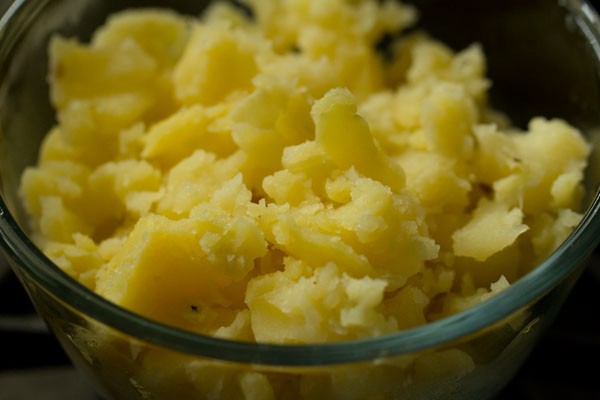
Sauté Spices & Onions
3. Heat 2 tablespoons oil in a pan, kadai or wok. Lower the heat and add 1 teaspoon mustard seeds. Crackle them.
You can use any neutral flavored oil.

4. Then, add 2 teaspoons husked split Bengal gram (chana dal), 1 teaspoon cumin seeds and 1 teaspoon husked split black gram (urad dal), optional.

5. Stir and fry till the lentils become golden. Ensure that the lentils turn golden but not get burnt. So, stir often on low heat.
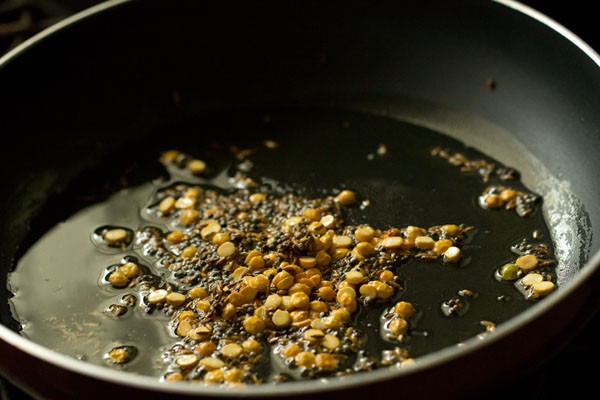
6. Add 2 teaspoons finely chopped ginger, 2 to 3 teaspoons chopped green chilies and 10 to 12 curry leaves. Stir and mix well.
You can reduce the quantity of green chilies, if you want. The chilies I used were very mild, so I added 2 of them.
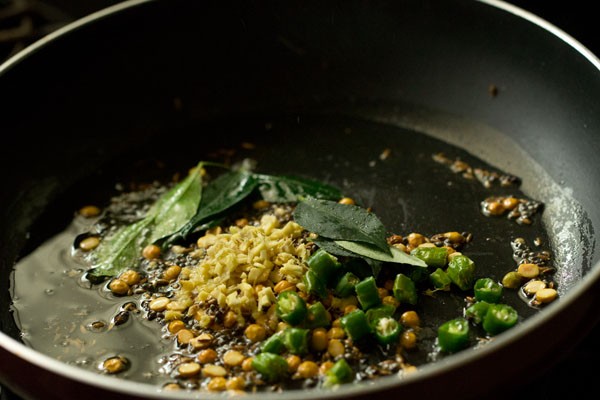
7. Then, add 8 to 10 chopped cashews.
Feel free to skip cashews, if you have nut allergy.

8. Stir and add 1 cup tightly packed thinly sliced onions (1 large onion, sliced).
Instead of onions, you can add shallots or pearl onions.
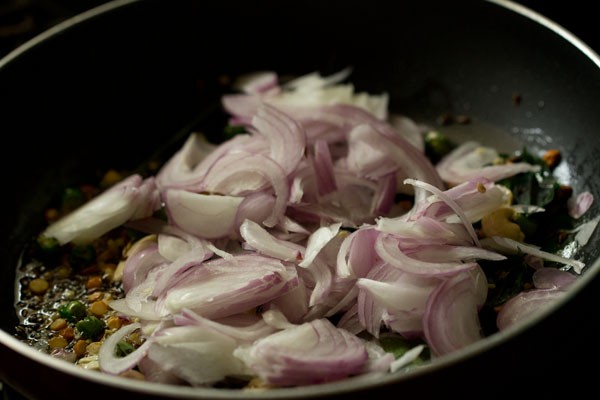
9. Add a pinch of asafoetida (hing) and ⅓ to ½ teaspoon turmeric powder.
To make a gluten-free dish, you can skip asafoetida and serve this Poori Curry with dosa, roti or poori made from gluten-free flours or millet flours.
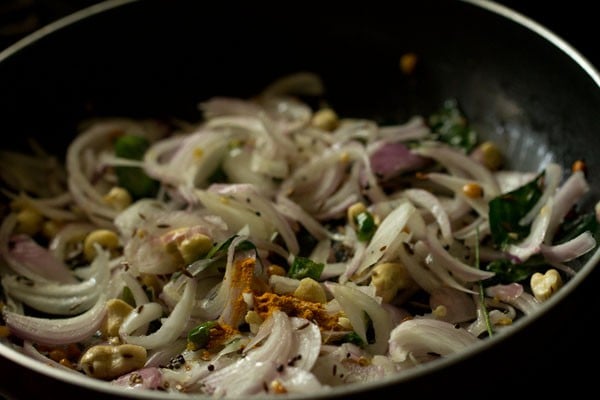
10. Stir and mix again very well. Sauté the onions on low to medium-low heat, stirring often, until they turn translucent and are softened.
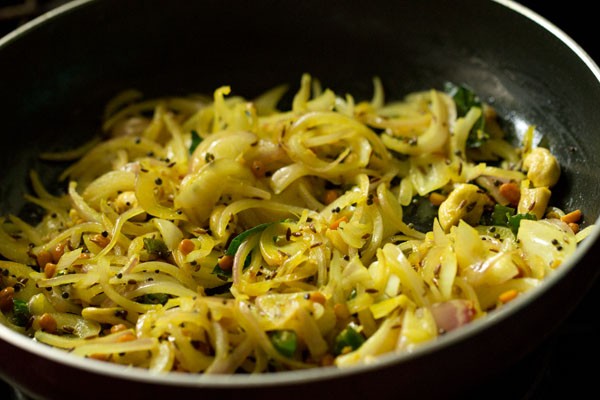
11. Now, add 2 teaspoons gram flour (besan).
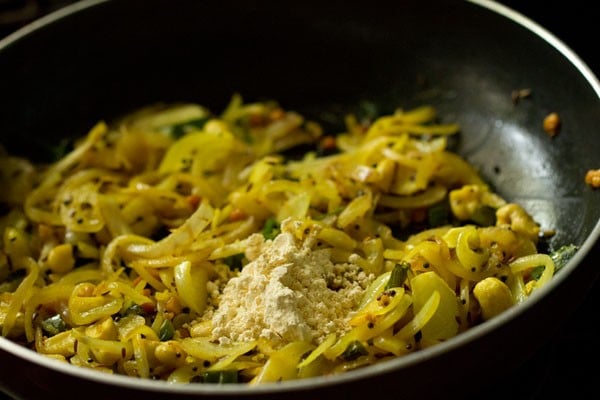
12. Stir and mix the gram flour very well with the rest of the ingredients.
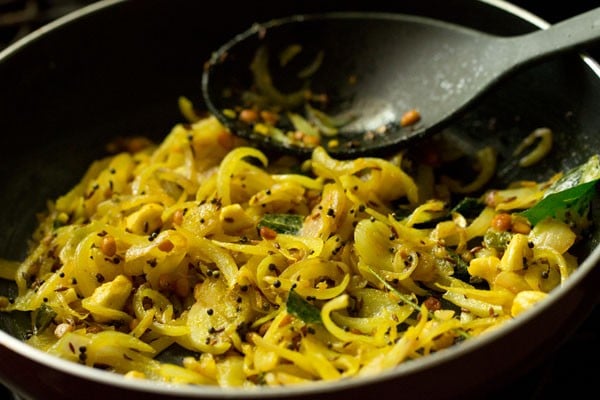
13. Add ¼ cup chopped tomatoes (1 small tomato, chopped). Stir and sauté the tomatoes for 2 minutes.
Tomatoes give a light tang to the dish. Adding tomato is optional and you can skip it.
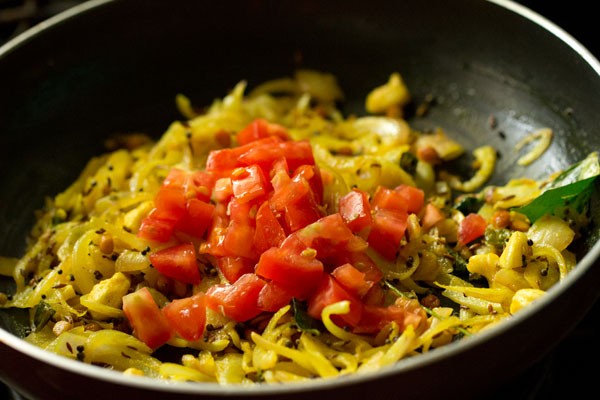
Make Poori Masala
14. Then, add 1.25 to 1.5 cups water.
You can vary the quantity of water depending upon the consistency you prefer. For a thicker consistency, add less water and for a slightly thinner gravy consistency, add a bit more water.
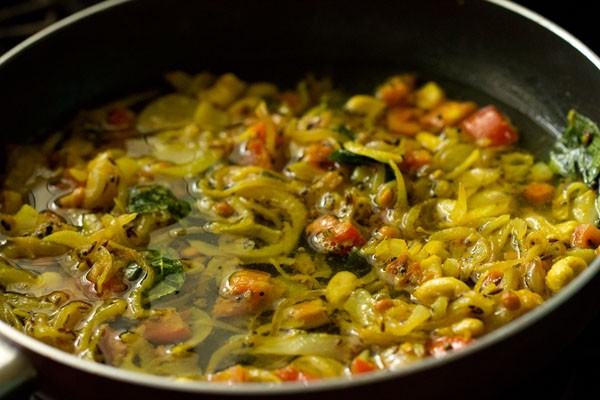
15. Stir and mix thoroughly

16. Bring this mixture to a simmer without a lid, on low to medium heat, for about 4 to 5 minutes.
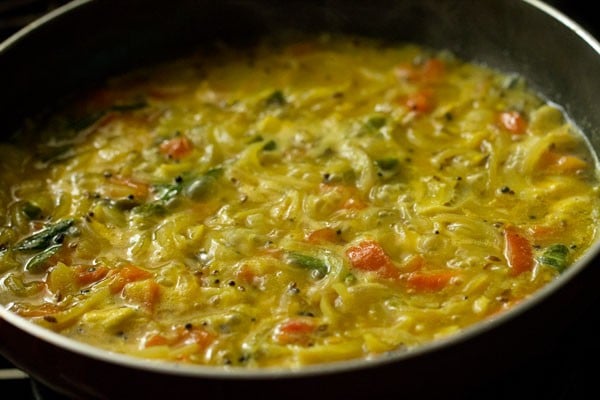
17. Now, add the crumbled or chopped potatoes and mix very well.

18. Cover the pan with a lid and simmer the curry on medium-low to medium heat for 4 to 5 minutes.
The curry will thicken and have the right consistency that is not too thick, nor thin. But according to your preferences, you can vary the consistency.
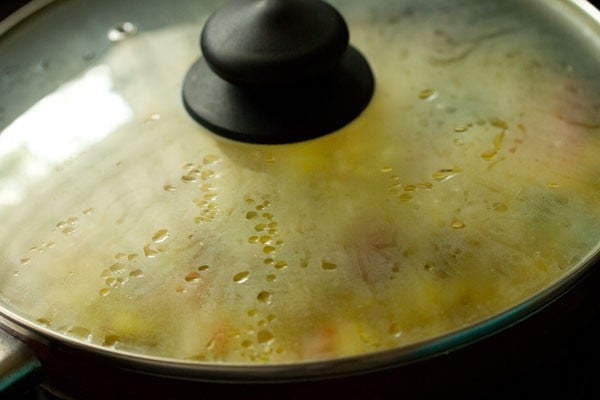
19. Season with salt as per taste. Mix the salt with the rest of the Poori Curry.
You can also add a bit of sugar, if you want.
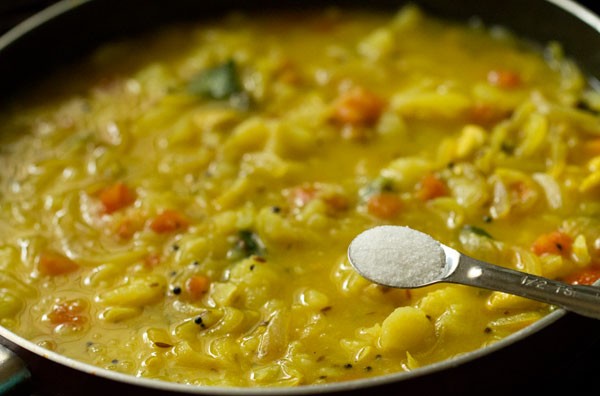
20. Lastly, add 2 to 3 tablespoons chopped coriander leaves. Mix very well and turn off the heat.
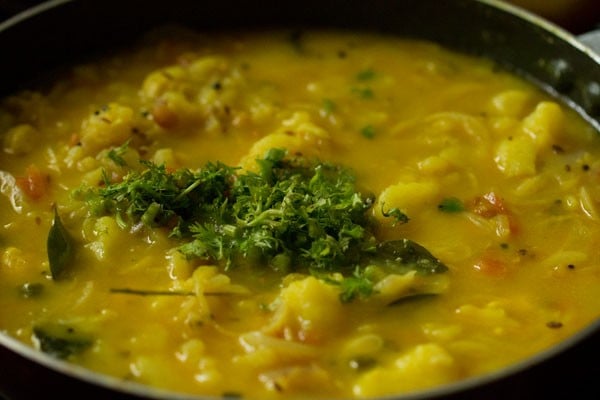
21. Serve South Indian style Poori Masala with poori, chapati, dosa or paratha.
It makes for a filling and comforting meal for breakfast or lunch.
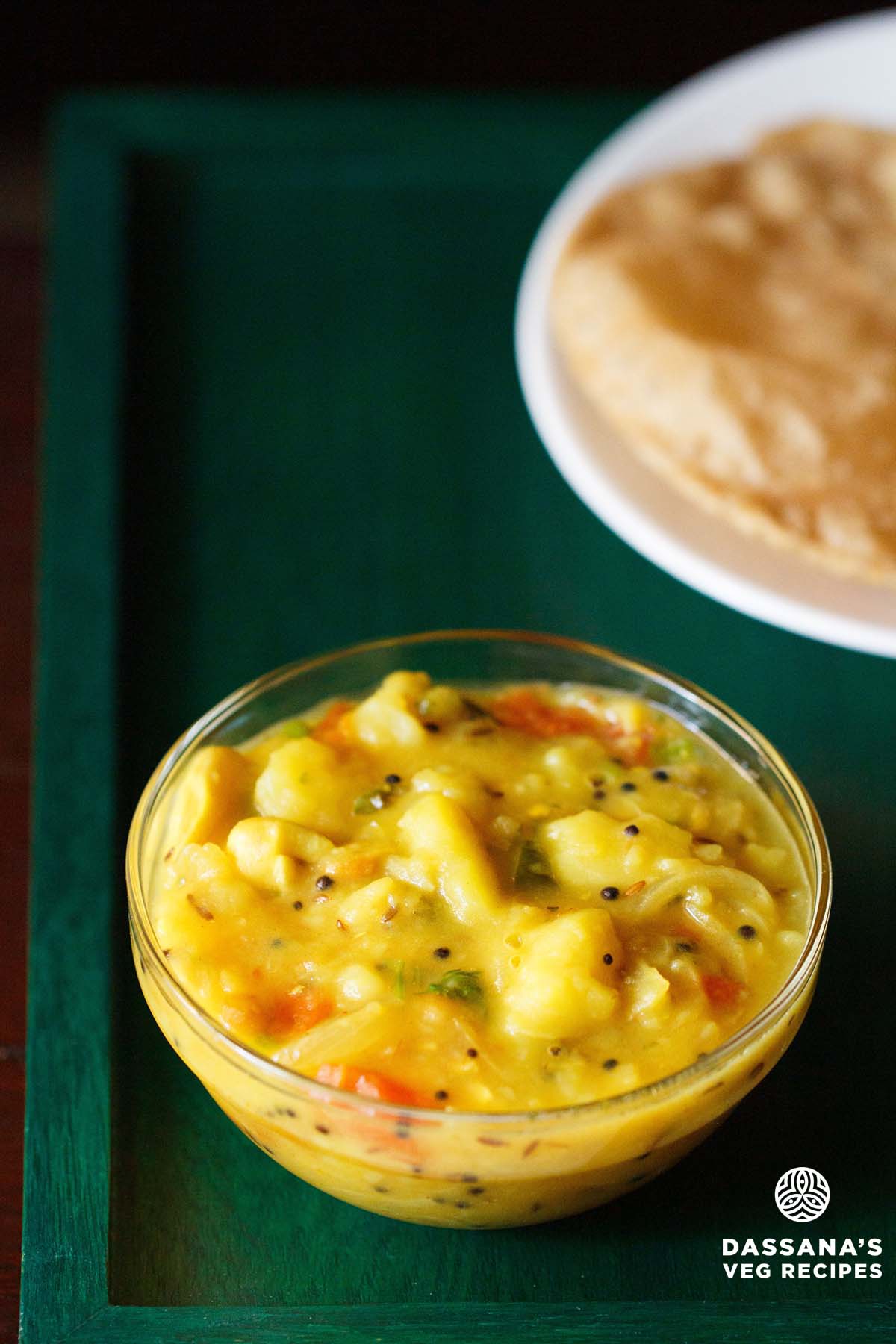
Expert Tips
- Use starchy potatoes types like Russet or Yukon Gold.
- The potatoes can be steamed or boiled in a stovetop pressure cooker, pan or Instant Pot, adding water as required.
- You can choose to skip the gram flour (besan), if you do not have it or swap it with chickpea flour.
- Alter the consistency of the gravy a bit by making it thick or slightly thin, by adding less or more water.
- For a gluten free version, skip asafoetida. And to make a gluten-free meal, serve the potato gravy with dosa or puri/roti made with gluten free flours or millet flours.
- Store any leftovers in the refrigerator for a day only. The leftover gravy can be reheated in a small frying pan or sauté pan, adding water as required, if in case the gravy has thickened.
FAQs
Poori Masala is a popular South Indian breakfast dish where deep-fried puffed bread (poori) is served with a spiced potato curry. The curry is often mildly spiced and flavored with turmeric, green chilies, ginger, and curry leaves, making it a flavorful yet comforting accompaniment.
Hotel Style Puri Curry tends to have a slightly richer flavor due to the use of more aromatic spices, cashews and a smooth, well-balanced texture. It is also often garnished with fresh coriander leaves and has a vibrant yellow color from turmeric.
Yes, you can store Poori Masala in an airtight container in the refrigerator for up to 1 day. Reheat it in a pan with a splash of water to adjust the consistency.
More South Indian Potato Recipes To Try!
Potato Recipes
Indian Street Food Recipes
Potato Recipes
Snacks Recipes
Please be sure to rate the recipe in the recipe card or leave a comment below if you have made it. For more vegetarian inspirations, Sign Up for my emails or follow me on Instagram, Youtube, Facebook, Pinterest or Twitter.
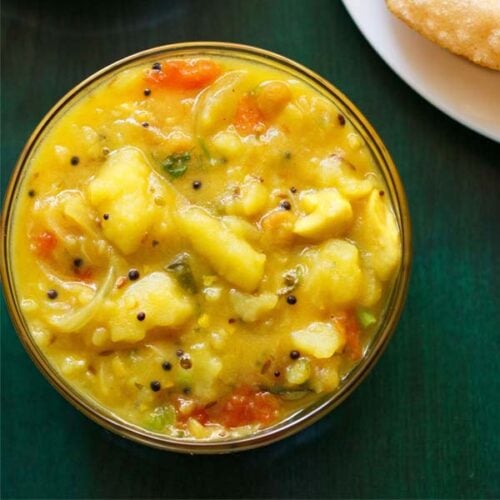
Poori Masala | Hotel Style Puri Curry Recipe
Ingredients
- 400 grams or 2 large potatoes or 2 cups tightly packed crumbled boiled potatoes
- 150 grams or 1 cup onions – thinly sliced
- 40 to 50 grams or ¼ cup tomatoes – chopped, optional
- 1 to 1.5 inches ginger or 2 teaspoons ginger – finely chopped
- 2 to 3 teaspoons green chilies – chopped, reduce the amount of green chilies for a less spicy curry
- 1 sprig curry leaves or 10 to 12 curry leaves
- 1 teaspoon mustard seeds
- 1 teaspoon cumin seeds
- 2 teaspoons chana dal (husked split bengal gram)
- 1 teaspoon urad dal (husked split black gram), optional
- 1 pinch asafoetida (hing)
- ⅓ to ½ teaspoon turmeric powder
- 8 to 10 cashews – chopped
- 2 teaspoons besan (gram flour)
- 1.25 to 1.5 cups water or add as required
- 2 to 3 tablespoons coriander leaves – chopped (cilantro)
- 2 tablespoons oil
- ½ teaspoon sugar or add as required, optional
- salt as required
Instructions
Preparation
- Rinse the potatoes very well in water Boil or steam them in a pressure cooker or steamer or Instant Pot. If pressure cooking, then pressure cook for 5 to 6 whistles on medium heat with water completely covering the potatoes.
- Cook potatoes until they are softened and fork tender. Drain the water and set aside the potatoes to cool.
- When the potatoes are still warm, peel and crumble them. You can also chop them and keep aside.
- Peel, rinse and thinly slice the onions. Also chop the tomatoes, ginger, green chilies and coriander leaves. Rinse and dry the curry leaves in a kitchen towel. Chop the cashews.
Sautéing spices, onions and tomatoes
- Heat in a pan or kadai (wok). Lower the heat and add mustard seeds. Crackle them.
- Then add the chana dal, cumin seeds and urad dal (optional).
- Stir and fry till the dals or lentils become golden ensuring that they do not burn.
- Add finely chopped ginger, chopped green chilies and curry leaves. Stir and mix well.
- Then add the cashews, which have been chopped. Mix again.
- Add the thinly sliced onions.
- Add a pinch of asafoetida and turmeric powder.
- Stir and mix again very well and sauté the onions till they become translucent and are softened.
- Now add the besan or gram flour. Mix the besan thoroughly with the rest of the ingredients.
- Add chopped tomatoes. Stir and sauté the tomatoes for 2 minutes.Adding tomatoes are optional and you can skip it.
Making Poori Masala
- Then add water. Mix very well.
- Bring this mixture to a simmer. About 4 to 5 minutes on a medium-low to medium heat.
- Now add the crumbled or chopped potatoes and stir very well.
- Cover and simmer the potato gravy for 4 to 5 minutes on a low to medium heat. The gravy should thicken and have a right consistency which is not too thick nor thin.
- Season with salt as per taste. Mix the salt with the rest of the potato gravy. You can also add a bit of sugar if you want.
- Lastly add the chopped coriander leaves. Stir very well and switch off the heat.
- Serve Poori Masala or Puri Curry with poori or chapati or dosa.
Nutrition Info (Approximate Values)
This Poori Masala recipe from the archives was first published in June 2015. It has been updated and republished on November 2024.

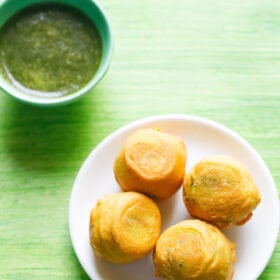
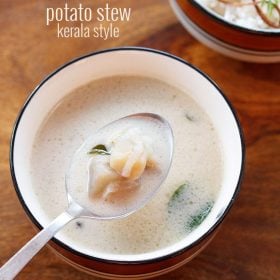

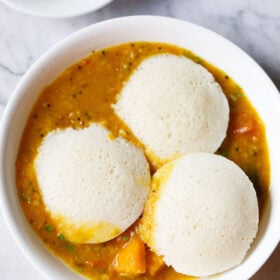
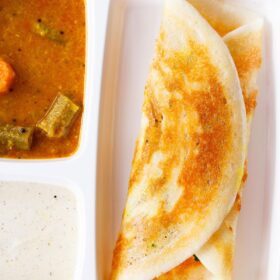

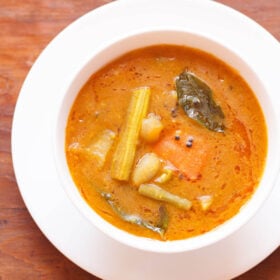









Wow its seems to be sooo yummy
thanks.
This is one of the most perfect dish I ever made..that day two of hubby’s friend appeared suddenly and immediately thought of making poori and this for breakfast. As it is quicker than our roti-vaji. I skipped curry leaves as cant tolerate the smell, didn’t have cashews, who cares!!Oooo….one friend said he would go to one indian restaurant and wait from 7 am to eat this same dish for breakfast and if he goes later wud finish. Couldn’t understand how I managed to duplicate. I am supposed to be Bangali…? The only prob was the poori disappeared faster than I could fry. Thank u soo much again , Dassana. I am getting quite addicted to indian cooking. Your layout for the recipes is the culprit-so intresting yet so simply shown. So much love for you.
thanks kimia. the way you have written shows the thankfulness and gratitude you have. thanks a ton 🙂
poori masala is a favorite south indian tiffin breakfast. the friend is right. if the taste is good, the poori masala disappears very fast. next time try adding a few curry leaves. they give a nice aroma. you can just add 3 to 4. you will get the authentic taste. cashews can be given a skip.
Superb. Made potato masala with pooris to day. It was terrific. Thank you.
thanks sethu for the feedback on both the recipes.
Mam its very interesting easy methods of cooking …… good recipes
thankyou so much hemavathi 🙂
Hi I m following u r receips very nice and thank you so much
welcome and thankyou kavya 🙂
Hi Dassana,
I’m going to try this recipe for lunch today. after browsing a few recipes i noticed you have a nice set of measuring spoons, where did you get them from?
i bought these measuring spoons from a local super store here. and thanks.
Hi , I should thank u for easy recipes….got interest in cooking after going through ur recipes..its really easy to make….
welcome gauri. glad to know this.
Hi Dassana
How r u…this might be unrelated but one of my friend is going to USA …can u suggest anything to get from there for me related to baking ingredients which u feel is worth buying there….expecting ur reply
helen, i am fine. i have no idea because most of baking stuff is available in india now. but you can go for good quality cocoa powder, vanilla extract, chocolate bars for baking.
You are just Superbbb…Before marriage I don’t like to go in kitchen.. but now I start cooking..after read your recipes now I am doing this with more an more interest…
thanks reena. nice to know this.
Nice recipe. Just found it while browsing my mobile phone…
Hii..mam I m maharashrtean but my hasbend is South this racepi is very useful for me..his like your all racepis then thanku so much …your racepi and this photos…
welcome priya. glad to know this.
Made this today, very nice easy dish.
thanks for the positive feedback james.
Hi,this is kishore,thank you for all your great work,I frequently follow this site,I have learn so much from this,recently I have tried this Poori masala,I don’t know so far that a gear chef hidden inside me ,that all credit goes to you only,after all thank you by now .
welcome kishore. nice to read your positive feedback. thanks for your kind words.
i like more in recipe is super
Hi dassana,
I tried this recipe today. Since I did not have green chilli , I added red chilli pdr and still It was excellent… Thanx again.
I hav a doubt.. Y is hing added to certain dishes only ?? Which kinda dishes is hing gen added ?? Is there any sp role of hing in enhancing the flavour or anything ??
Thanx in advance…
thanks for sharing the positive feedback kalpana. hing is added to not only give a subtle aroma to the dish but also it helps in digestion. in most potato based gravies or sabzis hing is added. in satvic indian cuisine, hing is used as a substitute for garlic and onions. so you will see that in most no onion no garlic recipes, hing is added. i also add hing in all the dals i make as it helps in digestion and give a nice aroma to the dish. though just add a pinch, otherwise the dish can get ruined with its strong pungent taste and flavor.
Hi dassana,
I tried your every version of potato gravy and they turn awesome. Thankyou for sharing nice and easy recipes.
I have one query regarding vanilla icecream which i tried…i think i come to soft serve after whisking cream for 2 minutes…then also there is ice crystal formation in icecream…i am going wrong somewhere…please help
Thank you
welcome rutba. if there are ice crystals you just whip the ice cream again and freeze it. some times ice crystals do appear in the ice cream. so the tip is to whip the ice cream and freeze it. this whipping of the ice cream can be done twice or thrice to get a softer texture.